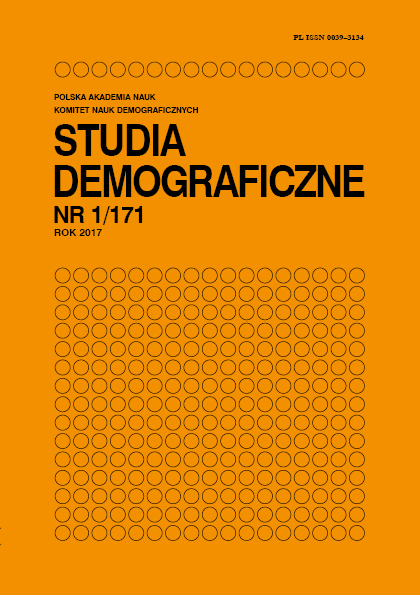Uwarunkowania skłonności do palenia papierosów. Wyniki modelowania równań strukturalnych
Main Article Content
Abstract
According to the age-period-cohort projection of lung cancer incidence (ICD-10 codes C33-C34), smoking prevention will be crucial for both men and women longevity. Lung cancer remains the main cancer cause of death among males in Poland. In 2014 the number of deaths in Poland caused by lung cancer among men was more than twice as high as for women. The study is focused on identification of attitudes influencing the propensity to smoke, which is performed by structural equation modelling (SEM) based on weighted least squares means and variance adjusted (WLSMV) estimation. Good fit of the presented models is demonstrated by RMSEA, NNFI and CFI values. Reliability of scales is assessed by ordinal alpha and ordinal theta coefficients.
Commitment to learning in childhood exhibits the highest standardized effect on propensity to smoke, which is an argument for youth smoking prevention. Structural equation model was estimated for men and women separately because of gender differences in smoking determinants. A strong character, individualism and self-reliance are the factors, which increase smoking propensity among males. These can be treated as features of masculinity and are not statistically important determinants of being a smoker for females. Depressive disorders, being a victim of violence as adults are statistically significant determinants of smoking among women.
Article Details
References
[2] Armor D., 1974, Theta Reliability and Factor Scaling, „Sociological Methodology”, nr 5, s. 17–50.
[3] Bentler P., 1992, On the Fit of Models to Covariances and Methodology to the Bulletin, „Psychological Bulletin”, nr 3, s. 400–404.
[4] Browne M., Cudeck R., 1993, Alternative Ways of Assessing Model Fit, „Sociological Methods & Research”, nr 2, s. 230–258.
[5] Cairns A., Blake D., Dowd K., 2006, A two-factor model for stochastic mortality with parameter uncertainty: theory and calibration, „Journal of Risk and Insurance”, nr 4, s. 687–718.
[6] Cronbach L., 1951, Coefficient Alpha and the Internal Structure of Tests, „Psychometrika”, nr 3, s. 297 – 334.
[7] Currie I., 2016, On fitting generalized linear and non-linear models of mortality, „Scandinavian Actuarial Journal”, nr 4, s. 356–383.
[8] Diagnoza Społeczna, 2015, Baza danych respondentów indywidualnych, Rada Monitoringu Społecznego, dostęp: 15.04.2017.
[9] Haustein K., 2006, Smoking and Poverty, „European Journal of Preventive Cardiology”, nr 3, s. 312–318.
[10] Hu L., Bentler, P., 1999, Cutoff criteria for fit indexes in covariance structure analysis: Conventional criteria versus new alternatives, „Structural Equation Modeling”, nr 6, s. 1–55.
[11] IARC, 2004, Tobacco Smoke and Involuntary Smoking, „IARC Monographs on the Evaluation of Carcinogenic Risks to Humans”, Lion.
[12] James W., 2002, Smoking, Sperm Quality and Testosterone Level, „Human Reproduction”, nr 12, s. 3275–3276.
[13] Johnson W., McGue M., Iacono W., 2007, Socioeconomic Status and School Grades: Placing their Association in Broader Context in a Sample of Biological and Adoptive Families, „Intelligence”, nr 6, s. 526–541.
[14] Jöreskog K., 1993, Testing Structural Equation Models, Bollen K., Long J., „Testing Structural Equation Models”, Newbury Park, Sage Publications.
[15] Kenny D., McCoach D., 2003, Effect of the Number of Variables on Measures of Fit in Structural Equation Modeling, „Structural Equation Modeling”, nr 3, s. 333–351.
[16] Kirkup J., 2014, Some people using foodbanks buy cigarettes instead of food, „The Telegraph”, nr 342, s. 15.
[17] Lang J., Abrams D., De Sterck H., 2015, The influence of societal individualism on a century of tobacco use: modelling the prevalence of smoking, „BMC Public Health”, nr 15, s. 1280–1292.
[18] Lee R., Carter L., 1992, Modeling and forecasting U.S. mortality, „Journal of the American Statistical Association” nr 87, s. 659–671.
[19] Matter G., 2013, Why Smokers Still Smoke, „The New York Times”, nr 207, s. 12.
[20] McDonald R., 1985, Factor analysis and related methods, Hillsdale, Erlbaum.
[21] Mermelstein R., 1999, Ethnicity, gender and risk factors for smoking initiation: An overview, „Nicotine Tobacco Research”, nr 1, s. 39–43.
[22] Munafò M., Zetteler J., Clark T., 2007, Personality and smoking status: A meta-analysis, „Nicotine & Tobacco Research”, nr 3, s. 405–413.
[23] Muthén B., 1983, Latent Variable Structural Equation Modeling with Categorical Data, „Journal of Econometrics”, nr 22, s. 43–65.
[24] Nowak S., 1973, Pojęcie postawy w teoriach i stosowanych badaniach społecznych, w: Nowak S. (red.). Teorie postaw, Warszawa, PWN, s. 17–88.
[25] O’Hagan E., 2012, Why do people smoke? Andrew Lansley doesn’t seem to know, „The Guardian”, nr 97, s. 15.
[26] Patton G., Carlin J., Coffey C., Wolfe R., Hibbert M., Bowes G., 1998, Depression, anxiety, and smoking initiation: a prospective study over 3 years, „American Journal of Public Health”, nr 10, s. 1518–1522.
[27] Pennanen M., Haukkala A., De Vries H., Vartiainen E., 2011, Academic achievement and smoking: is self-efficacy an important factor in understanding social inequalities in Finnish adolescents?, „Scandinavian Journal of Public Health”, nr 7, s. 714–722.
[28] Shalev I., Moffitt T., Sugden K., Williams B., Houts R., Danese A., Mill J., Arseneault L., Caspi A., 2013, Exposure to violence during childhood is associated with telomere erosion from 5 to 10 years of age: a longitudinal study, „Molecular Psychiatry”, nr 18, s. 576–581.
[29] Svartberg J., Jorde R., 2007, Endogenous Testosterone Levels and Smoking in Men. The Fifth Tromsø study, „International Journal of Andrology”, nr 3, s. 137–143.
[30] Vehkalahti K., Puntanen S., Tarkkonen L., 2006, Estimation of reliability: a better alternative for Cronbach’s alpha, „Reports on Mathematics”, nr 430, Uniwersytet w Helsinkach.
[31] Zumbo B., Gadermann A., Zeisser C., 2007, Ordinal Versions of Coefficients Alpha and Theta for Likert Rating Scales, „Journal of Modern Applied Statistical Methods”, nr 1, s. 21–29.
